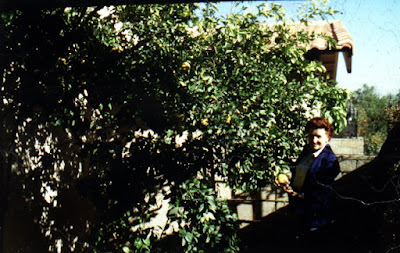 |
| Orange tree growing in southern Nevada |
Winter Low Temps
 |
| Sweet orange is tender to winter low temperatures in Las Vegas. Here the sweet orange died back to the more tolerant sour orange rootstock and it grew replacing the sweet orange. |
The second reason citrus fail to produce fruit here is, like any fruit tree, due to late spring frosts when it is flowering. Flowers, unlike the tree, can't handle any freezing temperatures or the flowers die and dont produce fruit. 'The tree might be able to but the flowers can't.
If a light freeze occurs once during its flowering time, there is a chance some fruit will be produced. If light spring frosts occur repeatedly over a couple weeks of flowering then it is likely there wont be any fruit produced. If a heavy spring freeze occurs then the whole crop is lost and maybe even the tree!
Flowering is Triggered by Stress
 |
| Draping burlap over citrus tree for cold protection in Las Vegas. Draping burlap over the tree keeps the wind off of the tree and may help reduce flower freezing by a couple of degrees. |
 |
| Sucker growth from trunk of Cara Cara Orange in southern Nevada |
Lemons and limes also flower in the spring but may flower intermittently throughout the year. Kumquat does not produce flowers or have a spring leaf flush of growth until about May so it typically will have fruit regardless. On top of that it is one of the more cold hardy citrus you can grow in southern Nevada. Flowering will occur after a rain similar to a drought-induced dormancy in the tropics. There is often a main flowering period with the onset of rain after a long dry season and a small flowering period following the end of a rainy season when there are intermittent short periods of drought and rain.
 |
| Citrus leaves yellowing due to intense desert sunlight |
Drought and Cold are Both Stressors
In Nevada orange, grapefruit and mandarin characteristically
flower for 2 to 4 weeks following the winter dormancy. Flowering starts just before
a spring growth flush of leaves, commonly seen in March. Out-of-season flowering
is occasionally seen in June or August but that is following a drought and then and rain or irrigation. Lemons and limes
also flower in the spring but may flower intermittently throughout the year.
Kumquat does not produce flowers or have a spring leaf flush of growth until about
May. Flowering will occur after a rain similar to a drought-induced dormancy in
the tropics. There is often a main flowering period with the onset of rain after
a long dry season and a small flowering period following the end of a rainy season
when there are intermittent short periods of drought and rain.
 |
| Hobby St. Denis and grapefruit tree in Las Vegas, 1995 |
Flowers Produced at Different Ages
Orange and grapefruit trees require 6-12 years to flower and fruit after planting young trees. Pistachios will be about the same. But grafts from the flowering portion of an older tree takes only three or four years! But the lower, older portion of that young seedling tree remains juvenile forever in exchange. Mandarins take only 5 years to start flowering, limes only 2-3 years and Key lime 1 to 2 years.
Once fruiting, most citrus are notorious for producing a smaller yield the following year after a full load of fruit. An example is the Murcott variety of mandarin. I tell people to not delay harvesting fruit from Myers lemon when ready because keeping fruit on the tree for a long time can result in smaller yields the following year. Myers lemon is ready to harvest in Las Vegas at the end of December to mid-January. When it is sweet to the taste, harvest the fruit.
Pruning Citrus and Fruiting
Pruning may delay flowering and fruit to the following year if its severe. It depends on the variety and how much pruning is done, but expect little to no flowering when trees are heavily pruned. Pruning citrus is done commercially to oranges and necessary for controlling the size of the tree and producing fruit regularly. But prune citrus with caution. Pruning can commonly result in reduced fruit and flowering on pruned portions of the tree. Annual or even every other year lightly pruning of the tree may be enough. Published research on best practices for pruning citrus is sparse.
Leaf loss due to winter freezes can decrease flowering and fruit production. Occasional leaf loss due to winter or spring freezing temperatures may not be a problem but regular early fall leaf loss will. Excessive watering and applications of fertilizer seem to have little effect on fruit production.
